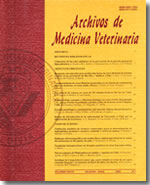Incorporation of escape cover in a model to estimate carrying capacity for white-tailed deer
Main Article Content
Abstract
The objective of this study was to establish the incorporation of escape cover in a carrying capacity (K) model for white-tailed deer (Odocoileus virginianus). The study was carried out in Santa Cruz Nuevo, Puebla, Mexico in an area of 50 Km2. The information was gathered through 13 transects of 800 by six m. The information served to establish the relationship between the escape cover and the faecal pellets of deer using a linear regression analysis. The relationship was included in a model for estimation of K, then a sensibility analysis was conducted. Faecal pellets were found in areas with an escape cover bigger than 59% and they were distributed in a cubic arrangement until reaching the 100%. The sensibility analysis showed that the escape cover and the brush vegetation were the main components to increase the carrying capacity whereas the body weight of the deer reduces the K.

